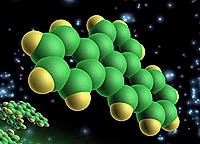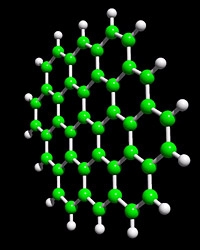
What do PAHs do in space?
Xander Tielens, Professor of Physics and Chemistry of the Interstellar Space, has been awarded an ERC Advanced Grant to study polycyclic aromatic hydrocarbons (PAHs) in space. The combination of astronomical observations, computer models and lab research makes the research highly interdisciplinary.

Xander Tielens: ‘There are two reasons why this research is so exciting and important. Firstly, we can shed light on the existence of a unique and complex molecular inventory in space, particularly in regions where stars and planets form, which probably comprise the prebiotic roots of life. Identifying specific molecules is the core aim of the research.
New tools to study the universe
‘The second reason is that the emission characteristics of these large molecules are a sensitive barometer for the local physical conditions. These molecules offer a unique and new possibility for studying the universe. This research aims to develop these molecules into a new 'tool' for astronomers with which they can chart the furthest reaches of the universe, using observations by the planned NASA mission, the James Webb Space Telescope.’
Organic materials

Polycyclic aromatic hydrocarbons (PAHs) have a poor name. They constitute a group of hundreds of organic materials made up of two or more benzene rings. We are familiar with these substances as the carcinogenic by-products of incomplete combustion of carbon-containing substances such as fossil fuels, grilled meat and other foodstuffs.
PAHs in space
PAHs also occur in interstellar space, in our own Milky Way, but also in other galaxies as far as the furthest - and therefore the earliest - universes. We know this because, aided by UV light particles, they emit fluorescent radiation in infrared. They are large molecules of some 50-100 carbon atoms, there are a lot of them, and they are everywhere, on almost all objects found in space, as observations with the Infrared Space Observatory (ISO) and the Spitzer have shown since the mid-nineties.
Chemical and physical characteristics
But so far all the evidence, however advanced, is still indirect. Specific PAHs, and even classes of PAHs have never been directly identified. Their chemical and physical characteristics are unknown to researchers, in spite of all the theoretical and experimental work that has been carried out since the seventies, in much of which Xander Tielens has played a pioneering role. As our knowledge of these chemical and physical characteristics is so limited, we also cannot state with certainty what they do in space, how they developed and what their function is, for example in star and planet formation.
Herschel

Source: Sterrewacht Leiden
Tielens will now be combining astronomical observations, theoretical models and laboratory experiments to study these PAHs further. The research programme is highly interdisciplinary. With his team of researchers, he intends to analyse the spectra that are exposed by the Spitzer and the ISO, and relate these to such aspects as the physical conditions in the the area of space in which they are found. Additional information on these conditions will be provided by the Herschel telescope that was launched earlier this year.
In the lab
In the lab, the team will be examining the characteristics of large PAH molecules in the gas phase, and will make computer models of the emission characteristics. By studying the photochemistry of the molecules, Tielens hopes to be able to comment on the chemical development of the molecules. The lab work will be carried out in the Sackler Laboratory for Astrophysics in Leiden and the Felix laser facility in the FOM Institute for Plasma Physics in Rijnhuizen.
'These molecules offer a unique and new possibility for studying the universe.'
Xander Tielens
Xander Tielens was appointed Professor of Physics and Chemistry of the Interstellar Space on 1 January 2009 at Leiden University, where he obtained his PhD in 1982. After obtaining his doctorate he left for the US where he worked at the National Research Council and subsequently at the University of California in Berkeley. From 1989 to 1997 Tielens was Senior Scientist in het NASA Ames Research Center in California. From 1997 to 2005 he was Professor of Astrophysics in Groningen. From 2005 to 2008 he was again a member of the NASA Ames Research Center. He was and still is affiliated to many international programmes for developing and applying new instruments for studying space. Between 2004 and 2008 he was also head of ‘The Molecular Universe’, a Marie Curie Research and Training Network. Tielens has won various prizes and has written a reference work: Physics and Chemistry of the Interstellar Medium (2005, 2nd edition 2006).
Fourth Advanced Grant
Tielens is the second Leiden astronomer to be selected for an Advanced Grant from the European Research Council. He was preceded last year by fellow astronomer Marijn Franx. Leiden physicists Michel Orrit and Carlo Beenakker have also received this prestigious subsidy. The Faculty of Science and the University Research Profile Area Fundamentals of Science have now attracted a total of four ERC Advanced Grants.
Links
- Personal page Prof. Xander Tielens
- Xander Tielens on the Leiden scientists website
- Sackler Laboratory for Astrophysics
- FOM Institute for Plasma Physics, Rijnhuizen
Previous articles in the University newsletter
Leiden ERC Advanced Grants
- Marijn Franx to study the earliest galaxies (19-08-2008)
- Paint molecules as informants (19-08-2008)
- Graphene is a thoroughbred that has to be tamed (17-03-2009)
Articles on astronomy in 2009
- New light on dark matter (30-09-2009)
- Strange spinning binary star explains 30 year old enigma (16-09-2009)
- What happens when two galaxies collide (14-07- 2009)
- Molecular mystery in space (16-06-2009)
Intercontinental supercomputer unravels structure of universe (9-06-2009) - Where were comet crystals formed? (19-05-2009)
- Planet formation: food for thought (21-04-2009)
- New research centre for studying planet and star formation (24-03-2009)
- Ewine van Dishoeck shows us new worlds in Dies lecture (03-02-2009)
